Analysis of Response Papers on Patient Safety in Healthcare
VerifiedAdded on 2022/12/19
|7
|1481
|26
Homework Assignment
AI Summary
This assignment presents an analysis of five response papers focusing on key healthcare topics. The papers discuss communicable diseases, diabetes management in the elderly and children, patient-centered care, and evidence-based practices in nursing. The author highlights the importance of nursing interventions, such as teaching and collaboration, and emphasizes the role of health screening and patient-centered approaches. The analysis examines barriers to patient-centered care, the correlation between patient-centered and evidence-based care, and the significance of cultural diversity in nursing. The author also underscores the importance of patient safety, the role of the Joint Commission, and the impact of education and leadership skills on patient outcomes. References from various sources, including the American Nurses Association and the Joint Commission, are provided to support the analysis.

RESPONSE PAPER 1
Response Paper
Student’s Name
Institutional Affiliation
Response Paper
Student’s Name
Institutional Affiliation
Paraphrase This Document
Need a fresh take? Get an instant paraphrase of this document with our AI Paraphraser

RESPONSE PAPER 2
Response Paper
Response # 1
Personally, "communicable disease" is a good topic that requires in-depth evaluation.
Such diseases spread very first within a very wide area thus presenting a need to explore them.
Curbing the crisis circumnavigating communicable diseases is vital for the wellbeing of society.
At an individual level, I am much pleased with the nursing interventions proposed within the
discussion presented. The interventions proposed through the discussion fully comply with the
principles of a registered nurse as brought forth by the World health organization. For instance,
teaching is a fundamental strategy in promoting community involvement in promoting wellbeing
(Regis College, 2018). The community should be taught about the dangers of communicable
diseases and empowered regarding the strategies involved in curbing the crisis. Additionally, a
collaborative approach is emphasized within the standards of a registered nurse. Collaboration in
the health care entity has proven to not only promote safety but also aid in enhancing patients'
satisfaction. I would also recommend health screening as proposed in the discussion as it
promotes accuracy in disease diagnosis.
Response #2
Diabetes is a vital crisis across the globe. Following this discussion, I am much pleased
with the choice of the target group as the elderly population is the most affected the disease.
However, I would suggest for emphasis on children as they are the second most affected group
regarding the crisis (Whiteman, 2019). The discussion proposes outreach as the first strategy in
dealing with the crisis. Personally, outreach is a vital strategy y as it is fundamental to gather
information not only about the target population but also regarding the risk factors associated
Response Paper
Response # 1
Personally, "communicable disease" is a good topic that requires in-depth evaluation.
Such diseases spread very first within a very wide area thus presenting a need to explore them.
Curbing the crisis circumnavigating communicable diseases is vital for the wellbeing of society.
At an individual level, I am much pleased with the nursing interventions proposed within the
discussion presented. The interventions proposed through the discussion fully comply with the
principles of a registered nurse as brought forth by the World health organization. For instance,
teaching is a fundamental strategy in promoting community involvement in promoting wellbeing
(Regis College, 2018). The community should be taught about the dangers of communicable
diseases and empowered regarding the strategies involved in curbing the crisis. Additionally, a
collaborative approach is emphasized within the standards of a registered nurse. Collaboration in
the health care entity has proven to not only promote safety but also aid in enhancing patients'
satisfaction. I would also recommend health screening as proposed in the discussion as it
promotes accuracy in disease diagnosis.
Response #2
Diabetes is a vital crisis across the globe. Following this discussion, I am much pleased
with the choice of the target group as the elderly population is the most affected the disease.
However, I would suggest for emphasis on children as they are the second most affected group
regarding the crisis (Whiteman, 2019). The discussion proposes outreach as the first strategy in
dealing with the crisis. Personally, outreach is a vital strategy y as it is fundamental to gather
information not only about the target population but also regarding the risk factors associated
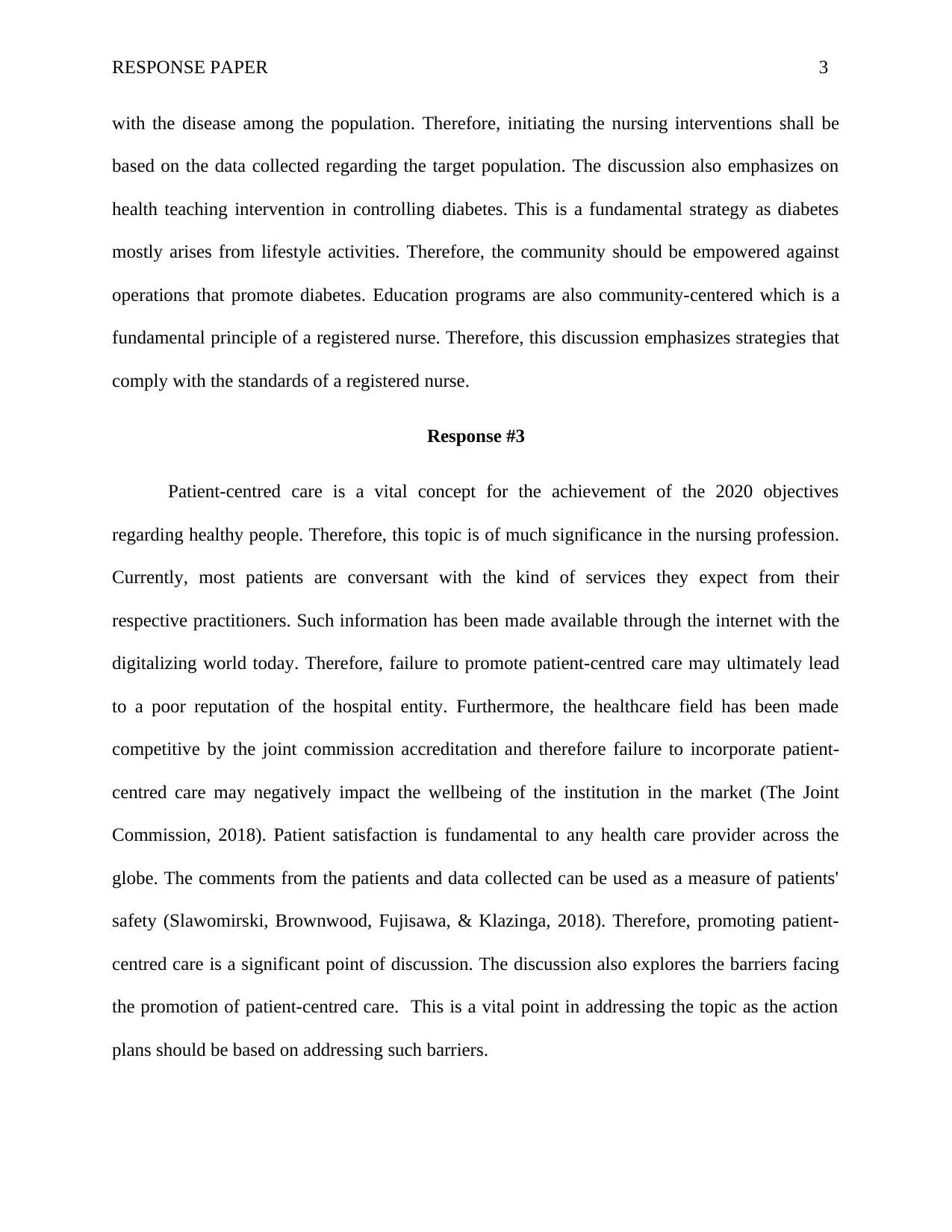
RESPONSE PAPER 3
with the disease among the population. Therefore, initiating the nursing interventions shall be
based on the data collected regarding the target population. The discussion also emphasizes on
health teaching intervention in controlling diabetes. This is a fundamental strategy as diabetes
mostly arises from lifestyle activities. Therefore, the community should be empowered against
operations that promote diabetes. Education programs are also community-centered which is a
fundamental principle of a registered nurse. Therefore, this discussion emphasizes strategies that
comply with the standards of a registered nurse.
Response #3
Patient-centred care is a vital concept for the achievement of the 2020 objectives
regarding healthy people. Therefore, this topic is of much significance in the nursing profession.
Currently, most patients are conversant with the kind of services they expect from their
respective practitioners. Such information has been made available through the internet with the
digitalizing world today. Therefore, failure to promote patient-centred care may ultimately lead
to a poor reputation of the hospital entity. Furthermore, the healthcare field has been made
competitive by the joint commission accreditation and therefore failure to incorporate patient-
centred care may negatively impact the wellbeing of the institution in the market (The Joint
Commission, 2018). Patient satisfaction is fundamental to any health care provider across the
globe. The comments from the patients and data collected can be used as a measure of patients'
safety (Slawomirski, Brownwood, Fujisawa, & Klazinga, 2018). Therefore, promoting patient-
centred care is a significant point of discussion. The discussion also explores the barriers facing
the promotion of patient-centred care. This is a vital point in addressing the topic as the action
plans should be based on addressing such barriers.
with the disease among the population. Therefore, initiating the nursing interventions shall be
based on the data collected regarding the target population. The discussion also emphasizes on
health teaching intervention in controlling diabetes. This is a fundamental strategy as diabetes
mostly arises from lifestyle activities. Therefore, the community should be empowered against
operations that promote diabetes. Education programs are also community-centered which is a
fundamental principle of a registered nurse. Therefore, this discussion emphasizes strategies that
comply with the standards of a registered nurse.
Response #3
Patient-centred care is a vital concept for the achievement of the 2020 objectives
regarding healthy people. Therefore, this topic is of much significance in the nursing profession.
Currently, most patients are conversant with the kind of services they expect from their
respective practitioners. Such information has been made available through the internet with the
digitalizing world today. Therefore, failure to promote patient-centred care may ultimately lead
to a poor reputation of the hospital entity. Furthermore, the healthcare field has been made
competitive by the joint commission accreditation and therefore failure to incorporate patient-
centred care may negatively impact the wellbeing of the institution in the market (The Joint
Commission, 2018). Patient satisfaction is fundamental to any health care provider across the
globe. The comments from the patients and data collected can be used as a measure of patients'
safety (Slawomirski, Brownwood, Fujisawa, & Klazinga, 2018). Therefore, promoting patient-
centred care is a significant point of discussion. The discussion also explores the barriers facing
the promotion of patient-centred care. This is a vital point in addressing the topic as the action
plans should be based on addressing such barriers.
⊘ This is a preview!⊘
Do you want full access?
Subscribe today to unlock all pages.

Trusted by 1+ million students worldwide
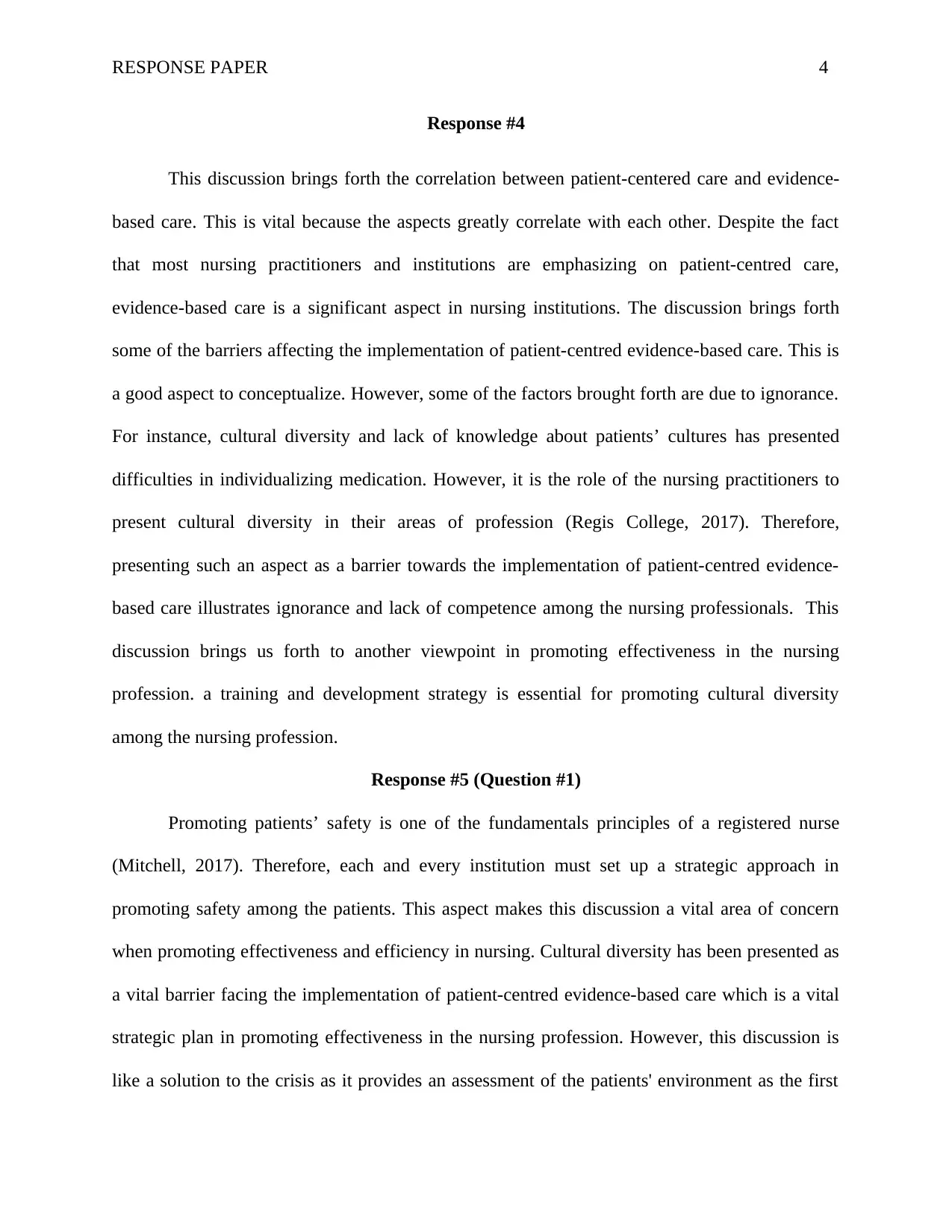
RESPONSE PAPER 4
Response #4
This discussion brings forth the correlation between patient-centered care and evidence-
based care. This is vital because the aspects greatly correlate with each other. Despite the fact
that most nursing practitioners and institutions are emphasizing on patient-centred care,
evidence-based care is a significant aspect in nursing institutions. The discussion brings forth
some of the barriers affecting the implementation of patient-centred evidence-based care. This is
a good aspect to conceptualize. However, some of the factors brought forth are due to ignorance.
For instance, cultural diversity and lack of knowledge about patients’ cultures has presented
difficulties in individualizing medication. However, it is the role of the nursing practitioners to
present cultural diversity in their areas of profession (Regis College, 2017). Therefore,
presenting such an aspect as a barrier towards the implementation of patient-centred evidence-
based care illustrates ignorance and lack of competence among the nursing professionals. This
discussion brings us forth to another viewpoint in promoting effectiveness in the nursing
profession. a training and development strategy is essential for promoting cultural diversity
among the nursing profession.
Response #5 (Question #1)
Promoting patients’ safety is one of the fundamentals principles of a registered nurse
(Mitchell, 2017). Therefore, each and every institution must set up a strategic approach in
promoting safety among the patients. This aspect makes this discussion a vital area of concern
when promoting effectiveness and efficiency in nursing. Cultural diversity has been presented as
a vital barrier facing the implementation of patient-centred evidence-based care which is a vital
strategic plan in promoting effectiveness in the nursing profession. However, this discussion is
like a solution to the crisis as it provides an assessment of the patients' environment as the first
Response #4
This discussion brings forth the correlation between patient-centered care and evidence-
based care. This is vital because the aspects greatly correlate with each other. Despite the fact
that most nursing practitioners and institutions are emphasizing on patient-centred care,
evidence-based care is a significant aspect in nursing institutions. The discussion brings forth
some of the barriers affecting the implementation of patient-centred evidence-based care. This is
a good aspect to conceptualize. However, some of the factors brought forth are due to ignorance.
For instance, cultural diversity and lack of knowledge about patients’ cultures has presented
difficulties in individualizing medication. However, it is the role of the nursing practitioners to
present cultural diversity in their areas of profession (Regis College, 2017). Therefore,
presenting such an aspect as a barrier towards the implementation of patient-centred evidence-
based care illustrates ignorance and lack of competence among the nursing professionals. This
discussion brings us forth to another viewpoint in promoting effectiveness in the nursing
profession. a training and development strategy is essential for promoting cultural diversity
among the nursing profession.
Response #5 (Question #1)
Promoting patients’ safety is one of the fundamentals principles of a registered nurse
(Mitchell, 2017). Therefore, each and every institution must set up a strategic approach in
promoting safety among the patients. This aspect makes this discussion a vital area of concern
when promoting effectiveness and efficiency in nursing. Cultural diversity has been presented as
a vital barrier facing the implementation of patient-centred evidence-based care which is a vital
strategic plan in promoting effectiveness in the nursing profession. However, this discussion is
like a solution to the crisis as it provides an assessment of the patients' environment as the first
Paraphrase This Document
Need a fresh take? Get an instant paraphrase of this document with our AI Paraphraser
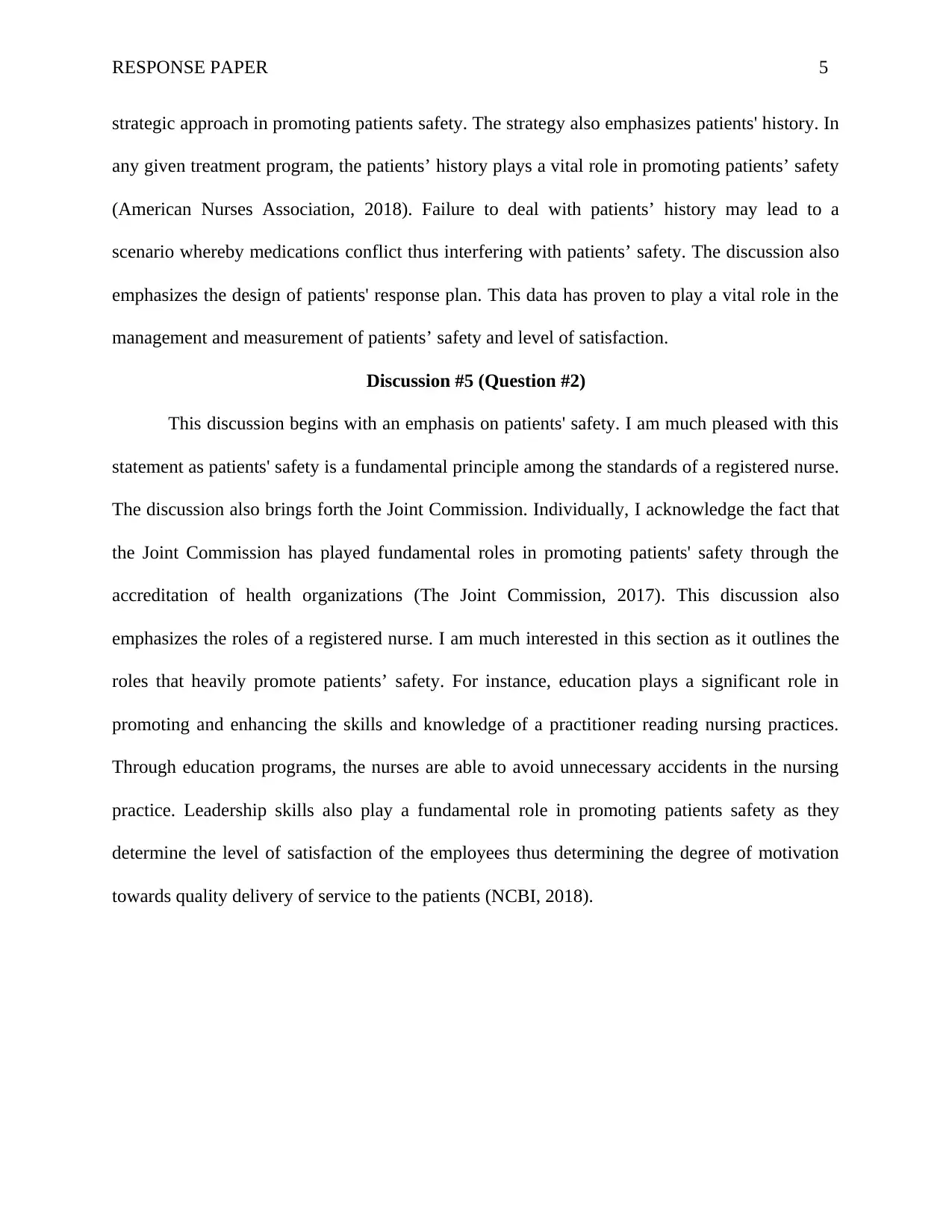
RESPONSE PAPER 5
strategic approach in promoting patients safety. The strategy also emphasizes patients' history. In
any given treatment program, the patients’ history plays a vital role in promoting patients’ safety
(American Nurses Association, 2018). Failure to deal with patients’ history may lead to a
scenario whereby medications conflict thus interfering with patients’ safety. The discussion also
emphasizes the design of patients' response plan. This data has proven to play a vital role in the
management and measurement of patients’ safety and level of satisfaction.
Discussion #5 (Question #2)
This discussion begins with an emphasis on patients' safety. I am much pleased with this
statement as patients' safety is a fundamental principle among the standards of a registered nurse.
The discussion also brings forth the Joint Commission. Individually, I acknowledge the fact that
the Joint Commission has played fundamental roles in promoting patients' safety through the
accreditation of health organizations (The Joint Commission, 2017). This discussion also
emphasizes the roles of a registered nurse. I am much interested in this section as it outlines the
roles that heavily promote patients’ safety. For instance, education plays a significant role in
promoting and enhancing the skills and knowledge of a practitioner reading nursing practices.
Through education programs, the nurses are able to avoid unnecessary accidents in the nursing
practice. Leadership skills also play a fundamental role in promoting patients safety as they
determine the level of satisfaction of the employees thus determining the degree of motivation
towards quality delivery of service to the patients (NCBI, 2018).
strategic approach in promoting patients safety. The strategy also emphasizes patients' history. In
any given treatment program, the patients’ history plays a vital role in promoting patients’ safety
(American Nurses Association, 2018). Failure to deal with patients’ history may lead to a
scenario whereby medications conflict thus interfering with patients’ safety. The discussion also
emphasizes the design of patients' response plan. This data has proven to play a vital role in the
management and measurement of patients’ safety and level of satisfaction.
Discussion #5 (Question #2)
This discussion begins with an emphasis on patients' safety. I am much pleased with this
statement as patients' safety is a fundamental principle among the standards of a registered nurse.
The discussion also brings forth the Joint Commission. Individually, I acknowledge the fact that
the Joint Commission has played fundamental roles in promoting patients' safety through the
accreditation of health organizations (The Joint Commission, 2017). This discussion also
emphasizes the roles of a registered nurse. I am much interested in this section as it outlines the
roles that heavily promote patients’ safety. For instance, education plays a significant role in
promoting and enhancing the skills and knowledge of a practitioner reading nursing practices.
Through education programs, the nurses are able to avoid unnecessary accidents in the nursing
practice. Leadership skills also play a fundamental role in promoting patients safety as they
determine the level of satisfaction of the employees thus determining the degree of motivation
towards quality delivery of service to the patients (NCBI, 2018).
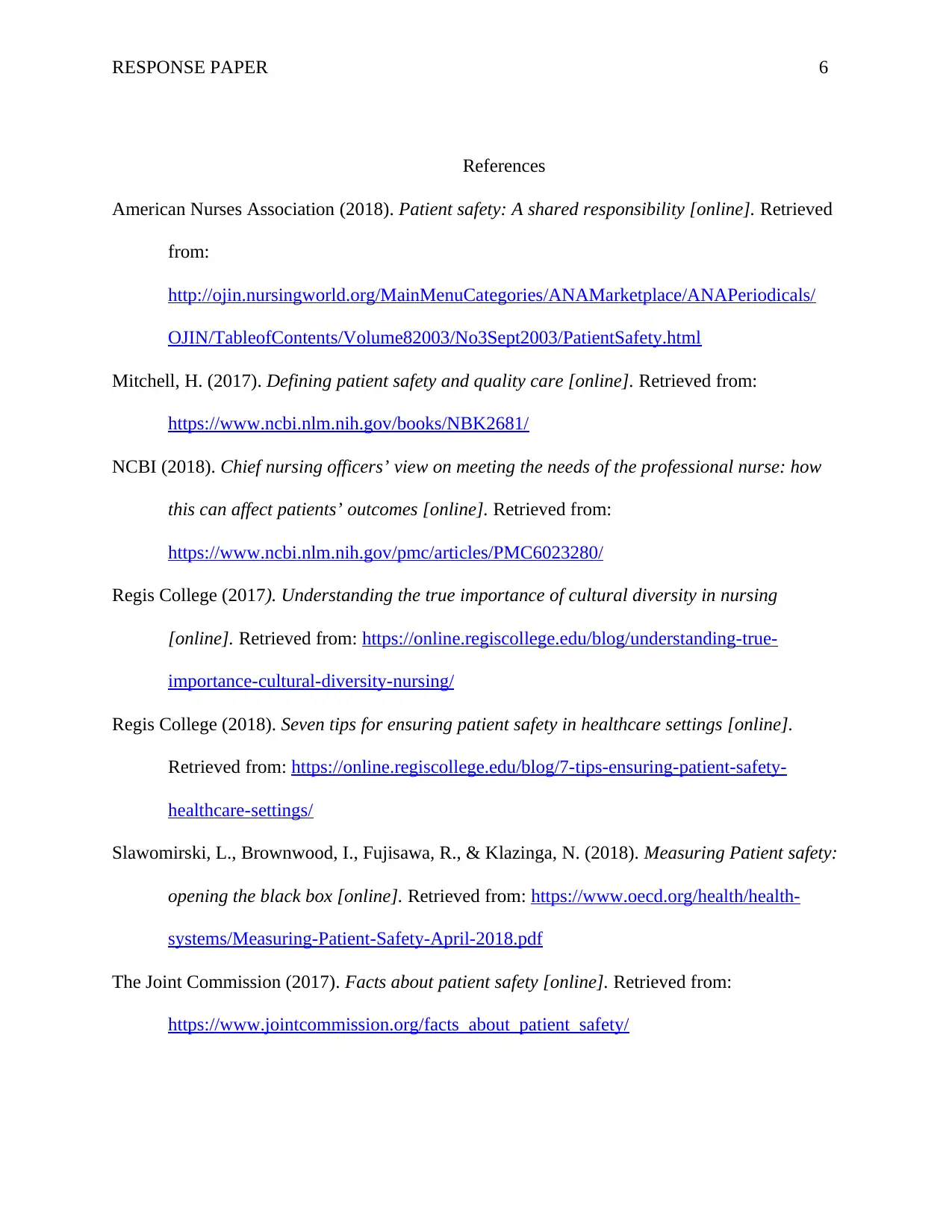
RESPONSE PAPER 6
References
American Nurses Association (2018). Patient safety: A shared responsibility [online]. Retrieved
from:
http://ojin.nursingworld.org/MainMenuCategories/ANAMarketplace/ANAPeriodicals/
OJIN/TableofContents/Volume82003/No3Sept2003/PatientSafety.html
Mitchell, H. (2017). Defining patient safety and quality care [online]. Retrieved from:
https://www.ncbi.nlm.nih.gov/books/NBK2681/
NCBI (2018). Chief nursing officers’ view on meeting the needs of the professional nurse: how
this can affect patients’ outcomes [online]. Retrieved from:
https://www.ncbi.nlm.nih.gov/pmc/articles/PMC6023280/
Regis College (2017). Understanding the true importance of cultural diversity in nursing
[online]. Retrieved from: https://online.regiscollege.edu/blog/understanding-true-
importance-cultural-diversity-nursing/
Regis College (2018). Seven tips for ensuring patient safety in healthcare settings [online].
Retrieved from: https://online.regiscollege.edu/blog/7-tips-ensuring-patient-safety-
healthcare-settings/
Slawomirski, L., Brownwood, I., Fujisawa, R., & Klazinga, N. (2018). Measuring Patient safety:
opening the black box [online]. Retrieved from: https://www.oecd.org/health/health-
systems/Measuring-Patient-Safety-April-2018.pdf
The Joint Commission (2017). Facts about patient safety [online]. Retrieved from:
https://www.jointcommission.org/facts_about_patient_safety/
References
American Nurses Association (2018). Patient safety: A shared responsibility [online]. Retrieved
from:
http://ojin.nursingworld.org/MainMenuCategories/ANAMarketplace/ANAPeriodicals/
OJIN/TableofContents/Volume82003/No3Sept2003/PatientSafety.html
Mitchell, H. (2017). Defining patient safety and quality care [online]. Retrieved from:
https://www.ncbi.nlm.nih.gov/books/NBK2681/
NCBI (2018). Chief nursing officers’ view on meeting the needs of the professional nurse: how
this can affect patients’ outcomes [online]. Retrieved from:
https://www.ncbi.nlm.nih.gov/pmc/articles/PMC6023280/
Regis College (2017). Understanding the true importance of cultural diversity in nursing
[online]. Retrieved from: https://online.regiscollege.edu/blog/understanding-true-
importance-cultural-diversity-nursing/
Regis College (2018). Seven tips for ensuring patient safety in healthcare settings [online].
Retrieved from: https://online.regiscollege.edu/blog/7-tips-ensuring-patient-safety-
healthcare-settings/
Slawomirski, L., Brownwood, I., Fujisawa, R., & Klazinga, N. (2018). Measuring Patient safety:
opening the black box [online]. Retrieved from: https://www.oecd.org/health/health-
systems/Measuring-Patient-Safety-April-2018.pdf
The Joint Commission (2017). Facts about patient safety [online]. Retrieved from:
https://www.jointcommission.org/facts_about_patient_safety/
⊘ This is a preview!⊘
Do you want full access?
Subscribe today to unlock all pages.

Trusted by 1+ million students worldwide
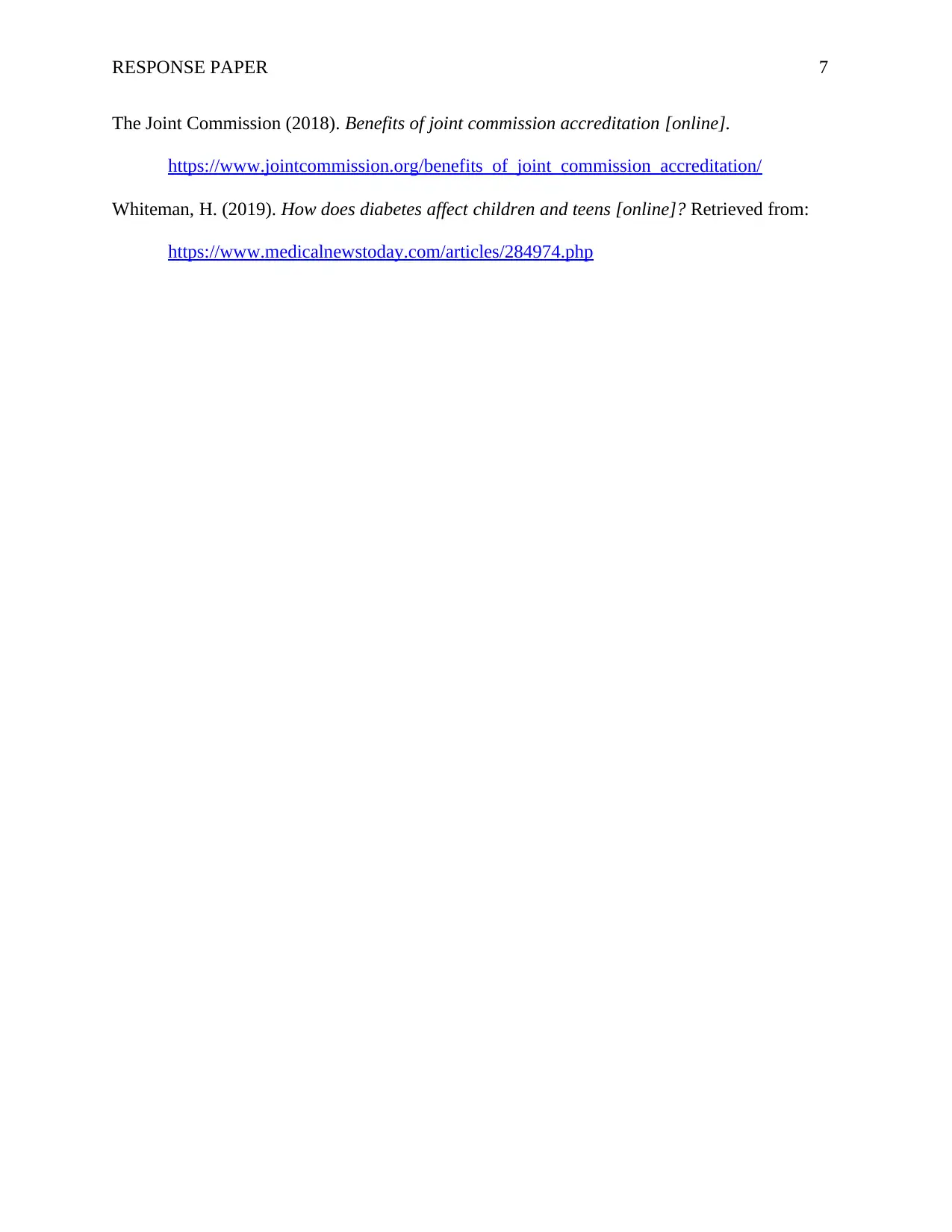
RESPONSE PAPER 7
The Joint Commission (2018). Benefits of joint commission accreditation [online].
https://www.jointcommission.org/benefits_of_joint_commission_accreditation/
Whiteman, H. (2019). How does diabetes affect children and teens [online]? Retrieved from:
https://www.medicalnewstoday.com/articles/284974.php
The Joint Commission (2018). Benefits of joint commission accreditation [online].
https://www.jointcommission.org/benefits_of_joint_commission_accreditation/
Whiteman, H. (2019). How does diabetes affect children and teens [online]? Retrieved from:
https://www.medicalnewstoday.com/articles/284974.php
1 out of 7
Related Documents
Your All-in-One AI-Powered Toolkit for Academic Success.
+13062052269
info@desklib.com
Available 24*7 on WhatsApp / Email
![[object Object]](/_next/static/media/star-bottom.7253800d.svg)
Unlock your academic potential
Copyright © 2020–2025 A2Z Services. All Rights Reserved. Developed and managed by ZUCOL.





